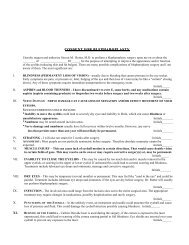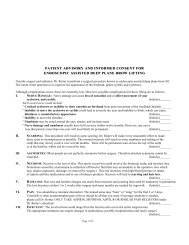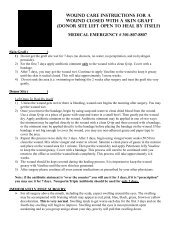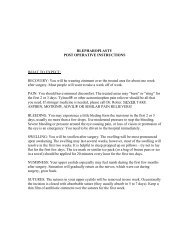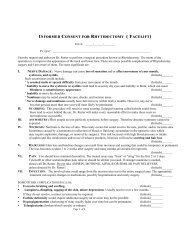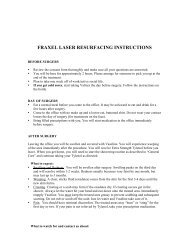wound care instructions for a cartilage graft - Center for Skin Surgery
wound care instructions for a cartilage graft - Center for Skin Surgery
wound care instructions for a cartilage graft - Center for Skin Surgery
You also want an ePaper? Increase the reach of your titles
YUMPU automatically turns print PDFs into web optimized ePapers that Google loves.
WOUND CARE INSTRUCTIONS<br />
FOR A CARTILAGE GRAFT<br />
MEDICAL EMERGENCY: PHONE 301-807-8807<br />
Cartilage Graft ( )<br />
1) Unless the <strong>wound</strong> gets wet or there is bleeding, <strong>wound</strong> <strong>care</strong> begins the morning after surgery.<br />
You may get the <strong>wound</strong> wet, you may shower, you may wash your face, and you may wash<br />
your hair.<br />
2) Once you remove the bandage, begin by using soap and water to clean dried blood from the<br />
<strong>wound</strong>. Use a clean Q-tip or a piece of gauze with soap and water in a small bowl. Gently pat<br />
the <strong>wound</strong> dry. Then apply antibiotic ointment to the <strong>wound</strong>. Antibiotic ointment may be<br />
applied in one of two ways: the ointment may be applied directly to the <strong>wound</strong> with a clean Q-<br />
tip and then covered with a bandage, or the ointment may be applied directly to the bandage<br />
be<strong>for</strong>e placing the bandage on the <strong>wound</strong>. If the bandage is not big enough to cover the<br />
<strong>wound</strong>, you may use non-adherent gauze and paper tape to cover the area. Repeat steps 2 and<br />
3 twice daily <strong>for</strong> 3 days.<br />
3) After 3 days begin using vinegar/water soaks (50/50) to clean the <strong>wound</strong>. Mix white vinegar<br />
and water in a bowl. Saturate a clean piece of gauze in the mixture and place on the <strong>wound</strong><br />
area <strong>for</strong> 1 minute. Then pat the <strong>wound</strong> dry and apply Petroleum Jelly Vaseline to keep the<br />
<strong>wound</strong> greasy. Cover with a bandage. This process will need to be continued until you return<br />
to the office or until the <strong>wound</strong> heals completely. The <strong>wound</strong> should be kept covered at all<br />
times during this process.<br />
Donor Site ( )<br />
1) Unless the <strong>wound</strong> gets wet or there is bleeding, <strong>wound</strong> <strong>care</strong> begins the morning after surgery.<br />
You may get the <strong>wound</strong> wet, you may shower, you may wash your face, and you may wash<br />
your hair.<br />
2) Once you remove the bandage, follow steps 2 and 3 above, twice daily <strong>for</strong> 3 days.<br />
3) After 3 days of the antibiotic ointment, apply Petroleum Jelly Vaseline to keep the <strong>wound</strong><br />
greasy <strong>for</strong> 7 more days.<br />
4) The donor site may be left uncovered after 3-4 days or you may continue to cover it <strong>for</strong> as<br />
long as you desire <strong>for</strong> cosmetic purposes, but it is important to place enough antibiotic<br />
ointment / vaseline on the <strong>wound</strong> to keep it greasy. Wound <strong>care</strong> is complete after 10 days<br />
unless there is oozing or a scab is present, at which point you will continue to apply vaseline.<br />
5) After surgery, please continue all your current medications as prescribed by your other<br />
physicians.<br />
Note: if the antibiotic ointment is “over the counter” you will use it <strong>for</strong> 3 days, if it is<br />
“prescription” you will use it <strong>for</strong> 7 days. It is important to keep the <strong>wound</strong> greasy with<br />
ointment/vaseline until the skin is sealed closed.<br />
IMMEDIATELY POST SURGERY<br />
For all surgery above the mouth, including the scalp, expect swelling around the eyes. The<br />
swelling may be accompanied with bruising which may appear as red, pink, blue, black, green,<br />
brown or yellow discoloration. This is very normal. Swelling tends to get worse each day <strong>for</strong><br />
the first 3 days and on the fourth day will begin to improve. Swelling around the eyes is most
prominent upon awakening and as you get up and go about your day, gravity will pull that<br />
swelling down.<br />
General In<strong>for</strong>mation<br />
a) There will be changes that occur during the healing period. In the second week a yellowishgreenish<br />
film will appear on the <strong>wound</strong>. This is protein (part of the foundation <strong>for</strong> healing). Do<br />
not remove this film. Continue <strong>wound</strong> <strong>care</strong> as described above. In the third week this will be<br />
replaced by a pinkish tissue. This is granulation tissue and is also normal. In the fourth week,<br />
skin will begin to grow in from the edges of the <strong>wound</strong> towards the center. Continue <strong>wound</strong><br />
<strong>care</strong> until the skin has covered the <strong>wound</strong> or until you return to the office.<br />
b) For <strong>wound</strong>s on the lower legs, there will be 2 finger widths of redness around the <strong>wound</strong><br />
during the healing period and this is very normal.<br />
c) Bleeding: In the event that bleeding should occur, remove the dressing and apply constant<br />
pressure directly on the bleeding area with gauze or a clean, dry towel <strong>for</strong> twenty minutes. Do<br />
not release pressure to check to see if the bleeding has stopped until after the 20 minutes<br />
has passed. If bleeding persists, call the doctor and/or go to the nearest emergency room<br />
unless otherwise instructed.<br />
d) Signs of Infection: fever, extreme redness, streaks of red, white fluid or pus, sharp pain, hot to<br />
the touch. If you suspect infection, please contact the office.<br />
e) Generally some revision will need to be done at a later time. Dr. Rotter will let you know<br />
when he will want to see you back.<br />
MEDICATION INFORMATION<br />
1. For post-operative pain control- take 2 Tylenol / Advil (or Ibuprofen) every 4 hours (or as directed on the<br />
label on the bottle) until you go to sleep. You will usually only need this medication <strong>for</strong> the first 24-48 hrs. If you<br />
have a history of gastrointestinal bleeding or are on blood thinners, we recommend you only take Tylenol after the<br />
first 24hrs.<br />
2. You have been prescribed pain medication, __________________ to be taken _________________. If you<br />
begin to experience nausea, discontinue the medication immediately, but be aware that this nausea may last <strong>for</strong><br />
24hrs. Eating some toast or some applesauce may alleviate these nausea symptoms.<br />
3. You have been prescribed an oral antibiotic, ________________ to be taken __________________, to prevent<br />
infection. Please take the antibiotic, with food, until it is completed. If you experience stomach upset, diarrhea or<br />
a rash, discontinue immediately and let us know.<br />
Please, feel free to call the office (703) 442 0300) at any time with your questions or concerns.<br />
Dr. Rotter will see you whenever needed. If you have any concern about the cosmetic result, we<br />
ask you to return in 3 to 4 months as sutures take time to dissolve and <strong>wound</strong>s take time to<br />
mature.<br />
Steven M. Rotter M.D.: _____________________________ Date: _______ / _______ / _______



